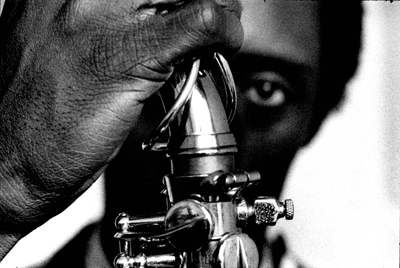Marion Brown, September 8, 1931 – Oct 18, 2010, was an ethnomusicologist and jazz alto saxophonist. He is best known for his participation in the 1960s avant-garde Jazz scene in New York City. He was a performer on Coltrane’s 1965 album Ascension. Brown was born in Atlanta in 1931. In 1953, he joined the Army and in 1956 enrolled at Clark College to study music. Brown moved to Atlanta in 1960 and studied pre-law for two years at Howard University. In 1962, Brown moved to New York, where he met poet Amiri Baraka, Sun Ra and Pharaoh Sanders. This period saw him appear on many important albums, including Shepp’s Fire Music, New Wave in Jazz, and most importantly John Coltrane’s Ascension. Brown traveled to Paris, France in 1967, where he discovered a love for architecture, Impressionistic art and Eric Satie’s music. He was an American Fellow at the Cite Internationale Des Artists Paris in the 1960s. He composed the soundtrack to Marcel Camus’ movie “Le Temps fou” in 1970. It featured Steve McCall and Barre Phillips as well as Ambrose Jackson, Gunter Hampel, and Ambrose Jackson. In 1970, he returned to the USA and felt a renewed sense of creativity. Brown was a resource teacher at a New Haven child study center. He worked there until 1971. He wrote and performed incidental music in a Georg Buchner play Woyzeck. Brown was an assistant professor at Bowdoin College, Brunswick, Maine in 1971. He held this position until he received his Bachelor’s degree. He has also held positions as an assistant professor at Brandeis University (1971-1974), Colby College (73-1974), Amherst College (1974-1975), and a graduate assistant at Wesleyan University (1974-1976). In 1976, Brown received a Master’s Degree in ethnomusicology at Wesleyan. His master’s thesis entitled “Faces and Places”: The Music and Travels a Contemporary Jazz Artist. Brown performed and composed throughout his various educational positions. Brown was awarded grants by the National Endowment for the Arts in 1972 and 1976. These grants allowed him to publish and compose pieces for solo piano. One of these pieces was inspired by Jean Toomer’s poetry in Cane. He also transcribed Eric Satie’s organ and piano music, including Pages Mysterieuses and Messe Des Pauvres. Also, he arranged Les Fils Des Etoiles by the composer for two guitars as well as a violin. Brown started to focus on painting and drawing in 1981. His charcoal portrait of Blind Lemon Jefferson, blues guitarist, was featured in “Jus’ Jass” an art exhibition at the New York City Kenkeleba Gallery. It also featured works by Charles Searles, Romare Bearden and Joe Overstreet. Brown has not recorded in over a decade. Brown has recorded solo as well as with Harold Budd, Mal Waldron, and Wadada Lee Smith. Brown has been ill in recent years. He is currently in a New York nursing home after a series of operations and a partial amputation. In 2005, he moved to an assisted living facility in Hollywood. Brown’s music has been influenced by many other music styles, including jazz avant-garde. Superchunk, an indie rock band, included “Song for Marion Brown”, a song on their Indoor Living album.
